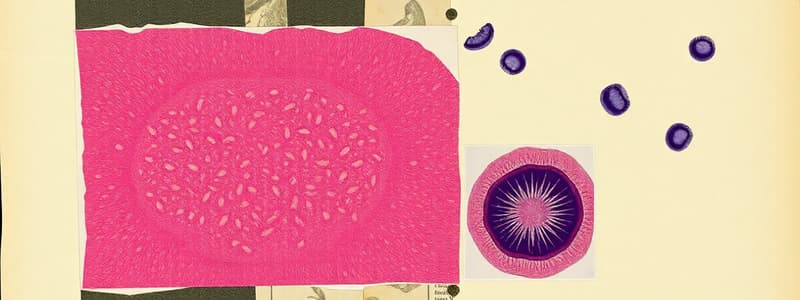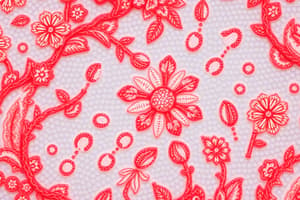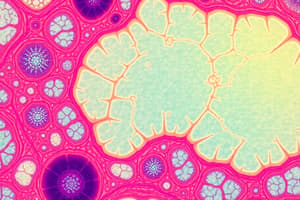Podcast
Questions and Answers
What is the location and function of simple cuboidal epithelial tissue?
What is the location and function of simple cuboidal epithelial tissue?
Location: Kidney, covers ovaries, lines kidney tubules, lines ducts of some glands. Function: Secretion and absorption.
Where can simple squamous epithelial tissue be found and what is its function?
Where can simple squamous epithelial tissue be found and what is its function?
Location: Sectioned lung slide, lines alveoli, capillary walls, blood vessels, Bowman's capsule of kidney, covers membranes. Function: Diffusion and filtration.
Describe the location and function of simple columnar epithelium.
Describe the location and function of simple columnar epithelium.
Location: Small intestine, lines uterus, lines ovarian tube (ciliated), lines most organs of the digestive system (non-ciliated). Function: Protects underlying tissues, secretes digestive fluids, absorbs digested nutrients; microvilli increase the surface area for more absorption.
Where is stratified squamous epithelium located?
Where is stratified squamous epithelium located?
Where is transitional epithelial tissue located and what are its functions?
Where is transitional epithelial tissue located and what are its functions?
What is the location and function of pseudostratified columnar ciliated epithelial tissue?
What is the location and function of pseudostratified columnar ciliated epithelial tissue?
Where is areolar tissue located and what does it do?
Where is areolar tissue located and what does it do?
Where can adipose tissue be found and what is its function?
Where can adipose tissue be found and what is its function?
What are the location and function of reticular tissue?
What are the location and function of reticular tissue?
Where is dense irregular connective tissue found and what is its function?
Where is dense irregular connective tissue found and what is its function?
Describe the location and function of dense regular connective tissue.
Describe the location and function of dense regular connective tissue.
Where can elastic connective tissue be located and what is its purpose?
Where can elastic connective tissue be located and what is its purpose?
What are the location and function of hyaline cartilage?
What are the location and function of hyaline cartilage?
What are the components of compact bone?
What are the components of compact bone?
Where is blood formed and what is its function?
Where is blood formed and what is its function?
What are the location and function of skeletal muscle tissue?
What are the location and function of skeletal muscle tissue?
Where is cardiac muscle tissue found and what does it do?
Where is cardiac muscle tissue found and what does it do?
What are the location and function of smooth muscle tissue?
What are the location and function of smooth muscle tissue?
Where is nervous tissue located and what is its function?
Where is nervous tissue located and what is its function?
Where can stratified squamous epithelial be found and what is its function?
Where can stratified squamous epithelial be found and what is its function?
What are the location and function of fibrocartilage?
What are the location and function of fibrocartilage?
Where is elastic cartilage located and what is its function?
Where is elastic cartilage located and what is its function?
Where is compact bone found and what is its function?
Where is compact bone found and what is its function?
What is the location and function of Spongy bone?
What is the location and function of Spongy bone?
Where is dense regular connective tissue located?
Where is dense regular connective tissue located?
What are the layers of plantar skin?
What are the layers of plantar skin?
Where is stratified cuboidal epithelial located and what is its function?
Where is stratified cuboidal epithelial located and what is its function?
Where is stratified columnar epithelial located?
Where is stratified columnar epithelial located?
Where can glandular epithelium be found and what is its function?
Where can glandular epithelium be found and what is its function?
Where can connective tissue specific (lymph) be found and what does it do?
Where can connective tissue specific (lymph) be found and what does it do?
Flashcards
Simple cuboidal epithelium
Simple cuboidal epithelium
Single layer of cube-shaped cells with centrally located nuclei; functions in secretion and absorption.
Simple squamous epithelium
Simple squamous epithelium
Single layer of thin, flat cells, optimized for diffusion and filtration. Nuclei are broad and thin.
Simple columnar epithelium
Simple columnar epithelium
Single layer of elongated cells, often with microvilli or goblet cells. Protects, secretes, and absorbs.
Transitional epithelium
Transitional epithelium
Provides an expandable lining; several layers of cuboidal cells that can stretch.
Signup and view all the flashcards
Pseudostratified columnar ciliated epithelium
Pseudostratified columnar ciliated epithelium
Appears layered, but all cells touch the basement membrane. Cilia sweep away mucus.
Signup and view all the flashcards
Areolar tissue
Areolar tissue
Delicate, thin membranes made of fibroblasts and a gel-like matrix. Binds skin to underlying organs.
Signup and view all the flashcards
Adipose tissue
Adipose tissue
Connective tissue that cushions, insulates, and stores energy. Cells store fat droplets.
Signup and view all the flashcards
Reticular tissue
Reticular tissue
Network of reticular fibers supporting white blood cells in lymphoid organs.
Signup and view all the flashcards
Dense irregular connective tissue
Dense irregular connective tissue
Irregularly arranged collagen fibers providing strength in multiple directions; found in the skin.
Signup and view all the flashcards
Dense regular connective tissue
Dense regular connective tissue
Parallel collagen fibers providing tensile strength in one direction; found in tendons and ligaments.
Signup and view all the flashcards
Elastic connective tissue
Elastic connective tissue
Dense regular connective tissue with a high proportion of what fibers; allows recoil after stretching.
Signup and view all the flashcards
Hyaline cartilage
Hyaline cartilage
Amorphous matrix with collagen fibers; supports, cushions, and resists compressive stress. Forms embryonic skeleton.
Signup and view all the flashcards
Compact bone
Compact bone
Bone cells (osteocytes) in concentric circles forming osteons (Haversian systems).
Signup and view all the flashcards
Blood
Blood
Red and white blood cells in a fluid matrix (plasma); transports gases, nutrients, and wastes.
Signup and view all the flashcards
Skeletal muscle tissue
Skeletal muscle tissue
Long, cylindrical, multinucleate cells providing voluntary movement.
Signup and view all the flashcards
Cardiac muscle tissue
Cardiac muscle tissue
Branching, striated, uninucleate cells connected by intercalated discs; pumps blood involuntarily.
Signup and view all the flashcards
Smooth muscle tissue
Smooth muscle tissue
Spindle-shaped, non-striated cells; provides involuntary movement in digestive tract and other organs.
Signup and view all the flashcards
Nervous tissue
Nervous tissue
Neurons transmit electrical signals; supporting cells protect and support neurons.
Signup and view all the flashcards
Stratified squamous epithelium
Stratified squamous epithelium
Multi-layered epithelium; keratinized form protects against water loss, non-keratinized lines moist areas.
Signup and view all the flashcards
Fibrocartilage
Fibrocartilage
Matrix with thick collagen fibers; absorbs compressive shock; found in intervertebral discs.
Signup and view all the flashcards
Elastic cartilage
Elastic cartilage
Matrix with elastic fibers; maintains shape while allowing flexibility; found in the ear and epiglottis.
Signup and view all the flashcards
Compact bone
Compact bone
Rigid connective tissue with minerals and collagen; supports, protects, and stores minerals.
Signup and view all the flashcards
Less dense bone with trabeculae; contains red marrow for hematopoiesis.
Less dense bone with trabeculae; contains red marrow for hematopoiesis.
Spongy bone (trabecular or cancellous bone), Connective tissue Specific (Bone or Osseous)
Signup and view all the flashcards
Stratified cuboidal epithelium
Stratified cuboidal epithelium
Two or three layers of cuboidal cells for protection; found in larger gland ducts.
Signup and view all the flashcards
Stratified columnar epithelium
Stratified columnar epithelium
Several layers of cells; superficial cells are elongated, basal cells are cube-shaped; found in male urethra.
Signup and view all the flashcards
Glandular epithelium
Glandular epithelium
One or more cells secreting substances into ducts or body fluids.
Signup and view all the flashcards
Lymph
Lymph
Fluid in lymphatic vessels; transports fat, tissue fluid and immune cells.
Signup and view all the flashcards
Stratified squamous epithelium (Non-keratinized)
Stratified squamous epithelium (Non-keratinized)
Esophagus is a non-keratinized type. Provides protective barrier.
Signup and view all the flashcards
Connective tissue specific (Bone or Osseous)
Connective tissue specific (Bone or Osseous)
Collagen fiber connective tissue, mostly made up of collagen.
Signup and view all the flashcards
dense regular connective tissue (proper dense)
dense regular connective tissue (proper dense)
Connective tissue located close to the bone.
Signup and view all the flashcardsStudy Notes
- The notes cover various tissue types, detailing their locations, functions, and structures.
- The tissue types include: epithelial, connective, muscle, and nervous tissue.
Simple Cuboidal Epithelial
- Location: Kidneys and ovaries, lining kidney tubules and ducts of some glands.
- Function: Secretion and absorption.
- Structure: Single layer, cube-shaped cells with centrally located, spherical nuclei.
Simple Squamous Epithelial
- Location: Lung alveoli, capillary walls, blood vessels, Bowman's capsule of the kidney, and covering membranes.
- Function: Diffusion and filtration.
- Structure: Single layer of thin, flat cells with broad, thin nuclei.
Simple Columnar Epithelium
- Location: Small intestine, uterus and ovarian tubes (ciliated), and most organs of the digestive system (non-ciliated).
- Function: Protects underlying tissues, secretes digestive fluids, and absorbs digested nutrients. Microvilli increase the surface area for absorption.
- Structure: Single layer of elongated cells, thick tissue with nuclei near the basement membrane.
Stratified Squamous Epithelium
- Location: Esophagus and outer layer of the skin (keratinized). Also lines the mouth, throat, vagina, and anal canal (non-keratinized).
- Function: Prevents water loss, blocks chemicals and microorganisms.
- Structure: Relatively thick, cells divide in deeper layers, pushing old cells upward. Keratinization provides a dry, tough covering of dead cells.
Transitional Epithelial
- Location: Bladder, ureters, and part of the urethra.
- Function: Provides an expandable lining and prevents diffusion from the urinary tract.
- Structure: Several layers of cuboidal cells able to stretch.
Pseudostratified Columnar Ciliated Epithelial
- Location: Trachea (ciliated) and epididymis/vas deferens (non-ciliated).
- Function: Goblet cells secrete mucus swept away by cilia; cilia move particles toward the pharynx (in the trachea).
- Structure: Appears layered due to nuclei at different levels, possesses cilia.
Areolar Tissue (Connective Tissue Proper - Loose)
- Location: Beneath layers of epithelium.
- Function: Binds skin to underlying organs and fills spaces between muscles.
- Structure: Delicate, thin membranes of fibroblasts in a gel-like matrix.
Adipose Tissue (Connective Tissue Proper - Loose)
- Location: Beneath the skin, between muscles, and around kidneys.
- Function: Cushions joints and organs, provides insulation, and stores energy.
- Structure: Cells store fat droplets, crowding out other cell types.
Reticular Tissue (Connective Tissue Proper - Loose)
- Location: Lymphoid organs (lymph nodes, bone marrow, and spleen) and liver.
- Function: Forms a soft internal skeleton (stroma) that supports other cell types like white blood cells, mast cells, and macrophages.
- Structure: Network of reticular fibers in a loose ground substance; reticular cells lie on the network.
Dense Irregular (Connective Tissue Proper - Dense)
- Location: Fibrous capsules of organs and joints, dermis of the skin, and submucosa of the digestive tract.
- Function: Withstands tension exerted in many directions and provides structural strength.
- Structure: Irregularly arranged collagen fibers, some elastic fibers, and fibroblasts.
Dense Regular (Connective Tissue Proper - Dense)
- Location: Tendons, most ligaments, and aponeuroses.
- Function: Attaches muscles to bones or to muscles, attaches bones to bones, and withstands great tensile stress when pulling force is applied in one direction.
- Structure: Parallel collagen fibers, few elastic fibers, and fibroblasts.
Elastic (Connective Tissue Proper - Dense)
- Location: Walls of large arteries, certain ligaments associated with the vertebral column, and walls of bronchial tubes.
- Function: Allows tissue recoil after stretching, maintains pulsatile blood flow, and aids lung recoil after inspiration.
- Structure: Dense regular connective tissue with a high proportion of elastic fibers.
Hyaline Cartilage (Connective Tissue - Specific, Cartilage)
- Location: Embryonic skeleton, ends of long bones in joint cavities, costal cartilages of ribs, cartilages of the nose, trachea, and larynx.
- Function: Supports and reinforces, serves as a resilient cushion, and resists compressive stress.
- Structure: Amorphous but firm matrix with an imperceptible collagen fiber network; chondroblasts produce the matrix, and chondrocytes lie in lacunae.
Compact Bone
- Location: Osteocytes (bone cells) form concentric circles in cross-section.
- Structure: Osteon - Haversian system.
Blood (Connective Tissue - Specific, Blood)
- Location: Forms in red bone marrow and inside blood vessels.
- Function: Transports respiratory gases, nutrients, wastes, and other substances, and maintains stable internal conditions.
- Structure: Red and white blood cells and platelets in a fluid matrix (plasma).
Skeletal Muscle Tissue
- Location: Attached to bone.
- Function: Moves head, trunk, limbs, facial expression, controlled by conscious effort (voluntary).
- Structure: Long, cylindrical, multinucleate cells.
Cardiac Muscle Tissue
- Location: Only in the heart.
- Function: Pumps blood, involuntary.
- Structure: Branching, striated, generally uninucleate cells that interdigitate at intercalated discs.
Smooth Muscle Tissue
- Location: Walls of hollow internal organs
- Function: Actions are involuntary, moves food through the digestive tract.
- Structure: No striations, shorter, spindle-shaped cells with central nuclei arranged closely to form sheets.
Nervous Tissue
- Location: Brain, spinal cord, ganglia, nerves.
- Function: Neurons transmit electrical signals from sensory receptors and to effectors (muscles and glands); supporting cells support and protect neurons.
- Structure: Neurons are branching cells with long processes extending from the cell body; non-excitable supporting cells.
Fibrocartilage (Connective Tissue - Specific, Cartilage)
- Location: Intervertebral discs, pubic symphysis, menisci of the knee joint.
- Function: Tensile strength allows it to absorb compressive shock.
- Structure: Matrix similar to hyaline cartilage, but less firm, contains thick collagen fibers.
Elastic Cartilage (Connective Tissue - Specific, Cartilage)
- Location: External ear (pinna) and epiglottis.
- Function: Maintains the shape of a structure while allowing great flexibility.
- Structure: Similar to hyaline cartilage, but with more elastic fibers in the matrix.
Compact (Cortical) Bone (Connective Tissue - Specific, Bone or Osseous)
- Location: Osteocytes (bone cells) form concentric circles in cross-section.
- Function: Internally supports body structures, provides protection, attachment for muscles, and stores/releases minerals (calcium).
- Structure: Rigid, contains minerals and a great amount of collagen. Osteon - Haversian system found here.
Spongy (Trabecular or Cancellous) Bone (Connective Tissue - Specific, Bone or Osseous)
- Location: Ends of long bones, proximal to joints, within the interior of vertebrae, and in the internal structure of short, flat, and irregular bones.
- Function: Contains red marrow (site for hematopoiesis) and provides support and protection for bone marrow.
- Structure: Less dense/lighter than compact bone, composed of trabeculae with open spaces.
Plantar Skin
- First layer: Keratinized epithelium.
- Second layer: Stratified squamous epithelium.
- Third layer: Dense irregular connective tissue.
Stratified Cuboidal Epithelial
- Location: Lines larger ducts of mammary glands, salivary glands, pancreas, and sweat glands.
- Function: Provides protection.
- Structure: Two or three layers of cuboidal cells.
Stratified Columnar Epithelial
- Location: Found in the male urethra.
- Function: Provides protection.
- Structure: Several layers of cells; superficial cells are elongated, basal cells are cube-shaped.
Glandular Epithelium
- Location: One or more of these cells constitutes a gland. Found within columnar and cuboidal epithelium.
- Function: Produce and secrete substances into ducts or body fluids.
- Structure: Specialized epithelial cells.
Lymph (Connective Tissue - Specific, Lymph)
- Location: Forms in tissue and located inside the lymphatic vessels.
- Function: Transports fat and other large molecules to the cardiovascular system, collects and transports tissue fluid back to circulation, and fluid matrix for the immune system.
- Structure: Fluid matrix (lymph).
Studying That Suits You
Use AI to generate personalized quizzes and flashcards to suit your learning preferences.




